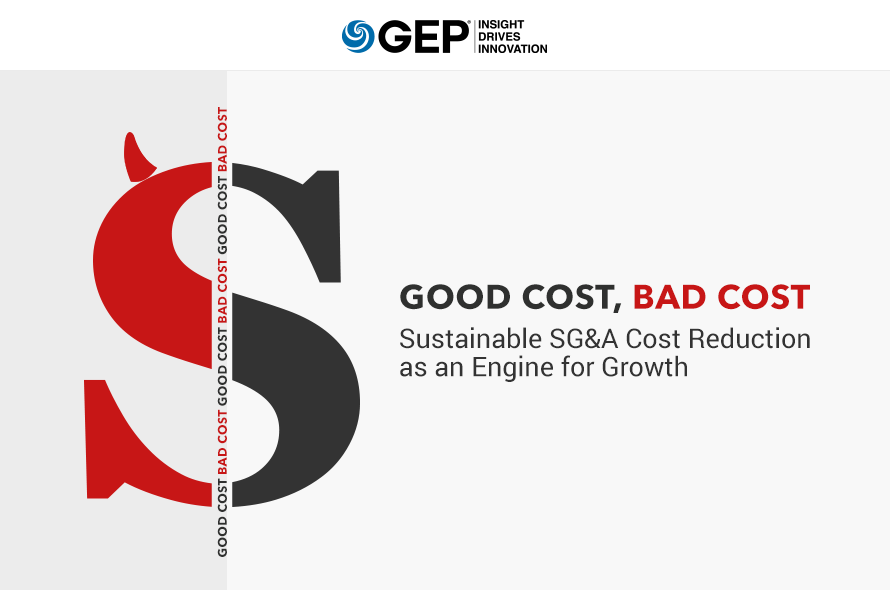Research shows that many enterprises fail to achieve the desired results from their cost management programs. They often make across-the-board cost cuts that are disconnected from the business strategy, unsustainable, and even a hindrance to enterprise growth.
In contrast, CFOs at the world’s most profitable and high-growth companies look at cost management as a means to support their business strategy and as an investment to fuel growth. They separate the good costs from the bad.
In an insightful new paper, Good Cost, Bad Cost: Sustainable SG&A Cost Reduction as an Engine for Growth, GEP shares a cost management framework to help identify costs that truly create value and competitive advantage for the business and the ones that don’t. The paper also discusses common barriers to effective cost management and strategies to overcome them.
It’s a must-read for CFOs and finance professionals seeking to build, and benefit from, an effective, sustainable cost management program.
Digitalization of data and advances in business technology are bringing unprecedented granularity and transparency of costs, across system and organizational silos, to intrepid organizations. Armed with better data and leadership focus, businesses can forensically examine their cost base bottom-up from a clean sheet and target areas for rapid cost take-out.
The short-term results can be impressive — anywhere between 15% and 35% in year one on SG&A costs, for example — yet businesses often struggle to sustain the momentum into subsequent years and see the benefits evaporating over time. They also find it challenging to strike a sustainable balance between optimizing costs and continuing to invest in business growth.
In this short paper, we set out a framework for sustainable cost reduction that enables organizations to create and implement a roadmap for extracting non-working dollars — and then rapidly investing them in growth areas.
Barriers to Sustainable Cost Reduction
- One Size Fits All: Not all costs are equal; organizations indiscriminately tackle “good” costs that support business growth and “bad” costs that don’t directly contribute to business value
- Delivered in Organizational Silos: Targets are set and budget holders left to deliver, without considering the duplication and waste that sit across the organization’s silos
- No Clear Roadmap: Initiatives are fragmented and often overlapping; limited consideration for limited organizational resources or capacity for change
- Lack of Controls: All the effort is put into identifying and executing cost reduction initiatives, but benefits are not realized or costs creep back in over time
- Misaligned Incentives: The reward for success is a smaller budget and new stretch targets. Money taken out is not reinvested and the best performers get another top-down target the following year
- Chasing the Dead Duck: Not knowing when to quit and change direction; all initiatives will not be successful
- Top Quartile Fallacy: Finally feeling you’ve reached the end because you’ve delivered your target; the world is changing fast and what was good yesterday may not be good tomorrow
The framework addresses the common barriers to sustainable cost reduction. It starts by examining cost holistically unconstrained by organizational silos, and then builds leadership alignment up front where the non-value-adding “bad” costs lie. It then identifies the right cost reduction levers in the right sequence, setting out a clear, integrated strategy — and puts in place the controls and leadership accountability to extract and sustain the benefits over time.
1. Build a Common Baseline
It seems obvious — start by understanding your costs. Yet the true source of cost is not always apparent when examined through a traditional financial or organizational lens.
Begin by building an integrated baseline of costs. Map expenses from across your organization to standard cost categories and allocate your people to their true function — not just where they sit in your organization.
Then map costs and people on to an organizational “world on a page” of the end-to-end activities and sub-activities across your internal value chain.
This is your starting place: a single, integrated view of the true costs mapped to the activities across organizational and geographic silos that you can use to align senior leadership around where — and how — to take cost out.
2. Align on “Good” and “Bad” Costs
“Good” costs relate to the value-adding activities that contribute directly to the business value proposition, whether customer- or product-focused. “Bad” costs relate to those activities that, while potentially necessary, don’t directly contribute business value.
It’s a powerful exercise to take your “world on a page” and, starting with your customer(s) as an example, identify those activities back through the value chain that contribute to business value — and those that don’t.
Then overlay different “cost lenses” to identify the key cost areas and target them for efficiency or effectiveness improvement. While not exhaustive, an example of cost lenses that can be analyzed include:
- Organizational Structure: What does spans and layers analysis say about your organizational shape? Is there duplication of services across regions and businesses?
- Functional and Cost Category Benchmarking: Benchmark at a function and category level to identify key cost areas where your organization spends significantly more per FTE than competitors.
- Digital: What does the breakdown of FTE and automation look like across your value chain?
This is not an activity to conduct as a desktop exercise, but should be used to get senior leadership aligned on where to focus cost reduction attention — so bring functional and business leadership together and conduct this as a team. Discuss what activities matter to your business growth — and where the key non-value-adding “bad” costs lie in your business.
3. Identify the Right Levers in the Right Sequence
Armed with a high-level understanding of the “bad” cost areas, establish cross-functional teams to deep dive into priority opportunity areas, evaluate potential cost take-out levers, and validate the size of prize.
The right lever will depend on the cost driver, for example:

- Demand Management: Can I reduce SG&A demand for activity by challenging the need and reducing customization — for instance, through zero-based budgeting?
- Process Improvement: Can I drive greater efficiencies and value from standardization and optimization of effort and activity?
- Automation: Can I industrialize or digitize certain processes to save time/cost?
- Centralization: Can non-automated processes be reconfigured to obtain efficiency improvements?
- Strategic Sourcing: Can I transfer some operations to onshore or offshore outsourcers to improve efficiency and flexibility?
Take the outputs from the deep dives and, as a team, evaluate and prioritize each opportunity based on benefits and ease of implementation, bundling opportunities into a phased roadmap to drive out costs.
4. Assign Senior Leadership Accountability
To ensure the longevity of your cost reduction initiative, embed cost ownership and accountability at the leadership and functional levels to baseline budgets and ensure buy-in to targets. Assign cost owners at each management level with senior management taking accountability for delivery.
Incentivize your organization by tying performance to targets, sharing the rewards, and reinvesting back into growth. Communication and transparency are key in this step. Make sure you also make the change visible and celebrate successes. Sustainable strategic cost reduction requires visible leadership buy-in, accountability, and aligned incentives throughout the organization. As is often repeated, culture trumps strategy.
5. Extract “Bad” Costs with Rigor and Discipline
Accountability and direction are important, but you also need to arm cost owners with tools to examine, challenge, and take action.
Embed controls within your organization to challenge costs, as they are committed. The entire organization should have one version of the truth in its data. Enable cost owners with forward-looking visibility of commitments against budgets, leveraging cloud technology and machine learning techniques to extract, harmonize, and consolidate disparate data.
And systematically and periodically, take stock of progress. If the benefits aren’t manifesting as anticipated, don’t continue to commit limited resources and leadership attention.
Conclusion
This framework is not an alternative to cost reduction tools such as zero-based budgeting, clean sheet analysis and strategic sourcing. Each of these are powerful cost reduction levers when applied to the right opportunity in the right sequence.
However, recognize that these are solutions. For holistic and sustainable cost reduction you need to acknowledge first that not all costs are the same; identify and sequence the right levers to remove “bad” costs; build leadership buy-in and accountability; and then put the rigor and controls in place to extract and sustain the benefits.

